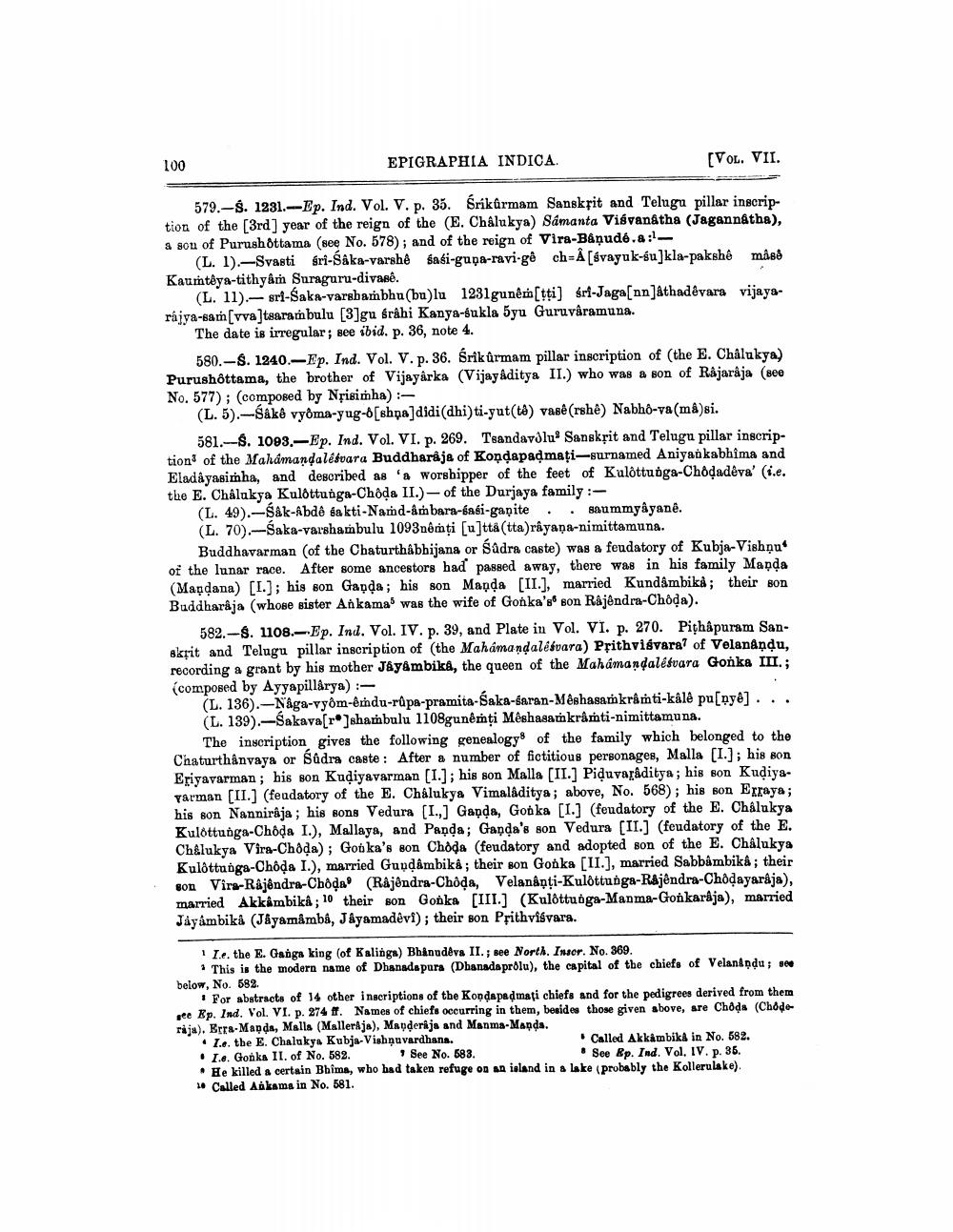________________
100
EPIGRAPHIA INDICA.
[VOL. VII.
579.-S. 1231.-Ep. Ind. Vol. V. p. 35. Śrikûrmam Sanskrit and Telugu pillar inscription of the [3rd] year of the reign of the (E. Chalukya) Samanta Viśvanatha (Jagannatha), a son of Purushottama (see No. 578); and of the reign of Vira-Baņudé.a:1
(L. 1). Svasti sri-Sâka-varshê sasi-gupa-ravi-gê ch-Â [évayuk-su]kla-pakshê måsê Kaumtêya-tithyâm Suraguru-divasê.
(L. 11)-sri-Saka-varshambhu (bu)lu 1231gunêm[ṭṭi] śri-Jaga[nn]âthadêvara vijayarajya-sam[vva]tsarambulu [3]gu śrâhi Kanya-sukla 5yu Guruvâramuna.
The date is irregular; see ibid. p. 36, note 4.
580.-S. 1240.-Ep. Ind. Vol. V. p. 36. Śrik ûrmam pillar inscription of (the E. Châlukya) Purushottama, the brother of Vijayarka (Vijayâditya II.) who was a son of Rajaraja (see No. 577); (composed by Nrisimha) :
(L. 5).-Saké vyôma-yug-ô[shpa]didi (dhi) ti-yut(tê) vasê (rshê) Nabhô-va (må)si.
581.-S. 1093.-Ep. Ind. Vol. VI. p. 269. Tsandavolu Sanskrit and Telugu pillar inscription of the Mahamandaléévara Buddharaja of Kondapaḍmați-surnamed Aniyankabhima and Eladâyasimha, and described as 'a worshipper of the feet of Kulôttunga-Chôdadêva' (i.e. the E. Chalukya Kulôttunga-Chôḍa II.)- of the Durjaya family :
(L. 49).-Sak-Abdê sakti-Namd-âmbara-sasi-ganite.. saummyâyanê. (L. 70).-Saka-varshambulu 1093nêmți [u]tta (tta)râyana-nimittamuna.
Buddhavarman (of the Chaturthâbhijana or Sâdra caste) was a feudatory of Kubja-Vishnu of the lunar race. After some ancestors had passed away, there was in his family Manda (Manḍana) [I]; his son Gapda; his son Manda [II], married Kundâmbikà; their son Buddharaja (whose sister Ankama was the wife of Gonka's son Râjêndra-Chôḍa).
582.-S. 1108.-Ep. Ind. Vol. IV. p. 39, and Plate in Vol. VI. p. 270. Pithapuram Sanskrit and Telugu pillar inscription of (the Mahamandaléśvara) Prithvisvara? of Velanâṇḍu, recording a grant by his mother Jâyâmbika, the queen of the Mahamandalésvara Gonka III.; (composed by Ayyapillarya) :
(L. 136).-Naga-vyôm-êmdu-rûpa-pramita-Saka-saran-Mêshasamkrâmti-kâlê pu[nyê]. (L. 139).-Sakava[r]shambulu 1108gunêmți Mêshasamkrâmti-nimittamuna.
The inscription gives the following genealogy of the family which belonged to the Chaturthânvaya or Sudra caste: After a number of fictitious personages, Malla [I]; his son Eriyavarman; his son Kudiyavarman [I.]; his son Malla [II.] Piduvarâditya; his son Kudiyavarman [II.] (feudatory of the E. Chalukya Vimalâditya; above, No. 568); his son Erraya; his son Nannirâja; his sons Vedura [I.,] Ganda, Gonka [I.] (feudatory of the E. Chalukya Kulottunga-Chôda I.), Mallaya, and Panda; Ganda's son Vedura [II.] (feudatory of the E. Chalukya Vira-Chôda); Gonka's son Choda (feudatory and adopted son of the E. Chalukya Kulôttunga-Chôda I.), married Gunḍâmbikâ; their son Gonka [II.], married Sabbâmbikâ; their son Vira-Rajendra-Chôda (Rajendra-Chôda, Velanânți-Kulôttunga-Rajendra-Chôḍayaraja), married Akkambikâ; 10 their son Gonka [III.] (Kulôttunga-Manma-Gonkaraja), married Jayambika (Jayamâmbâ, Jâyamadêvî); their son Prithvisvara.
1 I.e. the E. Ganga king (of Kalinga) Bhânudêva II.; see North. Insor. No. 369.
This is the modern name of Dhanadapura (Dhanada prolu), the capital of the chiefs of Velanându; see below, No. 582.
For abstracts of 14 other inscriptions of the Kondapaḍmati chiefs and for the pedigrees derived from them see Ep. Ind. Vol. VI. p. 274 ff. Names of chiefs occurring in them, besides those given above, are Chôda (Chôderaja). Erra-Manda, Malla (Mallerija), Manderâja and Manma-Manda.
I.e. the E. Chalukya Kubja-Vishnuvardhana.
Called Akkambika in No. 582.
I.e. Gonka II. of No. 582.
See No. 583.
See Ep. Ind. Vol. IV. p. 35.
He killed a certain Bhima, who had taken refuge on an island in a lake (probably the Kollerulake). 10 Called Ankama in No. 581.




